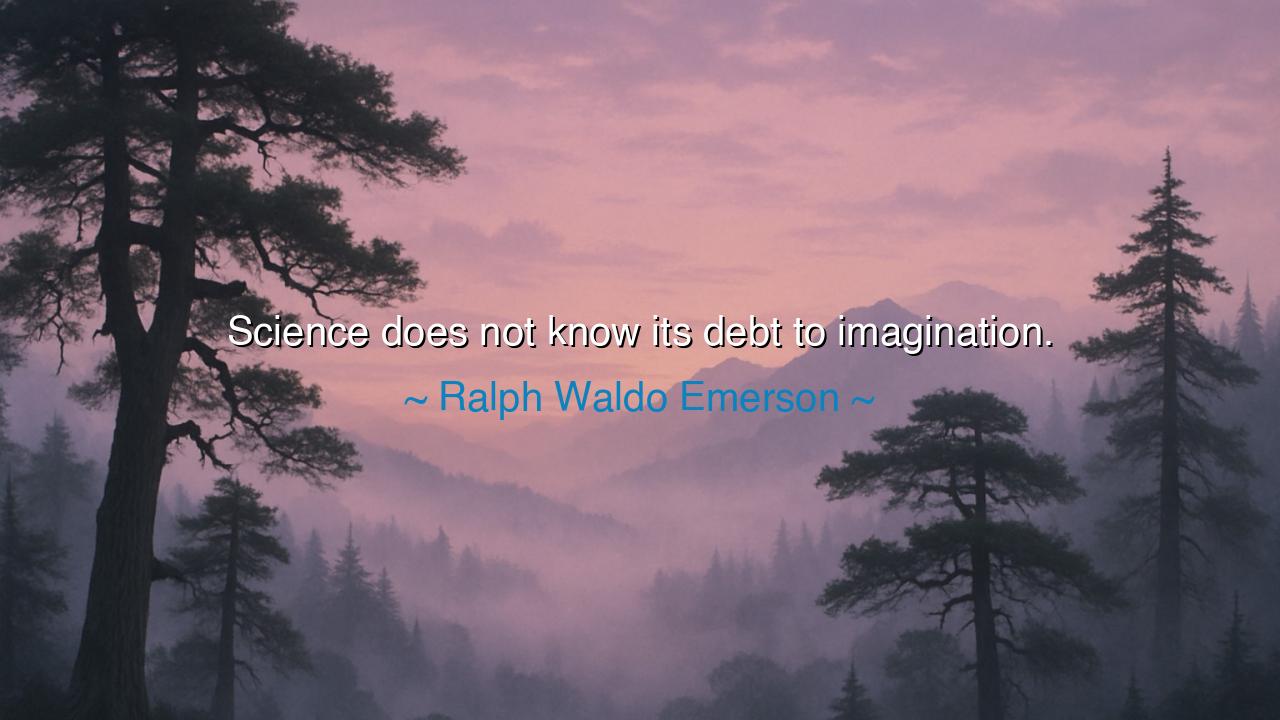
Science does not know its debt to imagination.






When Ralph Waldo Emerson wrote, “Science does not know its debt to imagination,” he spoke as both a philosopher and a prophet—a man who saw beyond the boundaries of reason into the vast terrain of the human spirit. His words were not a rebuke of science, but a reminder of its forgotten ancestry. For though science prides itself on logic, observation, and proof, it was born from the womb of imagination. Every discovery that reshaped the world first appeared not in a laboratory, but in the dreaming mind of one who dared to ask, What if? Emerson’s wisdom calls us to remember that before there was knowledge, there was vision, and before understanding, there was wonder.
The origin of this thought lies in Emerson’s transcendental philosophy—a belief that truth is not confined to what can be measured, but flows also from intuition and inspiration. He lived in an age when the industrial world exalted reason above all else, when science seemed to replace spirit as the new god of certainty. But Emerson, ever the seer, knew that even the most rational pursuit rests upon a foundation of imagination. The scientist who observes nature must first imagine that nature hides patterns; the mathematician must first imagine that numbers reveal the order of the universe. Without the spark of imagination, science would remain a map without roads, a lantern without flame.
Throughout history, the great scientists have been dreamers first and analysts second. Consider Isaac Newton, who sat beneath an apple tree and saw not merely a falling fruit, but the invisible hand of gravity binding the cosmos. That vision—the leap from the mundane to the universal—was an act of imagination. Or think of Albert Einstein, who did not discover relativity through equations alone, but through daydreams of riding upon a beam of light. His thought experiments were not the product of calculation, but of creative vision. When he later said, “Imagination is more important than knowledge,” he echoed Emerson’s truth—that the seed of discovery is not reason but wonder.
Even in the humblest acts of science, imagination is the silent architect. Before the astronomer builds a telescope, he imagines worlds unseen. Before the physician cures, she imagines a body restored to health. Before the inventor constructs, he imagines what has never been. The scientific method may refine the process, but it is imagination that sets it in motion. Science, therefore, owes its very existence to the creative power it often overlooks—the power to dream beyond the known, to see unity in chaos, to believe that mystery can be unveiled.
Emerson’s words also speak of humility. He warns that science, in its pride, may forget the source of its strength. When it denies the imagination, it risks becoming sterile—able to measure, but unable to marvel; able to analyze, but unable to create. For the imagination is not the enemy of reason, but its ally. It gives direction to curiosity, meaning to discovery, and soul to knowledge. Without imagination, science may build machines, but not meaning; it may cure the body, but not heal the heart. To be whole, the human intellect must honor both reason and vision, both the microscope and the dream.
There is a tale told of Galileo, who, gazing through his crude telescope, saw moons circling Jupiter and dared to imagine a universe larger than any man had conceived. For this vision, he was condemned by his time. Yet it was imagination—not rebellion—that guided his eye and steadied his hand. He looked at the heavens and did not merely see what was, but what could be understood. His imagination became the bridge between mystery and truth. And so it has always been: every revolution in thought begins as a rebellion of imagination against the limits of knowledge.
So, my listener, take this teaching to heart: do not separate imagination from knowledge, nor wonder from wisdom. Whether you are a scientist, artist, teacher, or thinker, remember that all progress begins in the unseen realm of vision. Exercise your imagination as you would a sacred muscle. Let curiosity and creativity walk hand in hand, and you will see the world not only as it is, but as it might yet become. When you gaze upon the stars, do not stop at what your eyes can see—ask what your heart can imagine.
For as Ralph Waldo Emerson reminds us, science owes a silent, unending debt to imagination. It is imagination that breathes life into numbers, meaning into facts, and divinity into discovery. To imagine is to participate in creation itself—to stand with one foot upon the earth and one in eternity. And those who dare to imagine boldly ensure that the light of human understanding will never fade, but will forever reach toward the infinite.






AAdministratorAdministrator
Welcome, honored guests. Please leave a comment, we will respond soon